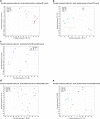Molecular control of endurance training adaptation in male mouse skeletal muscle
- PMID: 37697056
- PMCID: PMC10663156
- DOI: 10.1038/s42255-023-00891-y
Molecular control of endurance training adaptation in male mouse skeletal muscle
Abstract
Skeletal muscle has an enormous plastic potential to adapt to various external and internal perturbations. Although morphological changes in endurance-trained muscles are well described, the molecular underpinnings of training adaptation are poorly understood. We therefore aimed to elucidate the molecular signature of muscles of trained male mice and unravel the training status-dependent responses to an acute bout of exercise. Our results reveal that, even though at baseline an unexpectedly low number of genes define the trained muscle, training status substantially affects the transcriptional response to an acute challenge, both quantitatively and qualitatively, in part associated with epigenetic modifications. Finally, transiently activated factors such as the peroxisome proliferator-activated receptor-γ coactivator 1α are indispensable for normal training adaptation. Together, these results provide a molecular framework of the temporal and training status-dependent exercise response that underpins muscle plasticity in training.
© 2023. The Author(s).
Conflict of interest statement
The authors declare no competing interests.
Figures
















References
MeSH terms
Grants and funding
- 145005/SNSF_/Swiss National Science Foundation/Switzerland
- 310030_184832/Schweizerischer Nationalfonds zur Förderung der Wissenschaftlichen Forschung (Swiss National Science Foundation)
- 031L0101D/Bundesministerium für Bildung und Forschung (Federal Ministry of Education and Research)
- n/a/Universität Basel (University of Basel)
- 616830-MUSCLE_NET/EC | EC Seventh Framework Programm | FP7 Ideas: European Research Council (FP7-IDEAS-ERC - Specific Programme: "Ideas" Implementing the Seventh Framework Programme of the European Community for Research, Technological Development and Demonstration Activities (2007 to 2013))
LinkOut - more resources
Full Text Sources
Medical
Molecular Biology Databases

